Causes
Stamp Act:
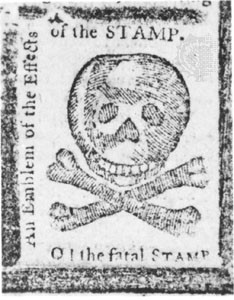
The Stamp Act was a Tax on bought and sold items
Source: http://historicstjohnschurch.org/news/the-stamp-act
The British were in debt from the expenses of the seven years war so their idea was to create a tax on documents. In 1765 The stamp act was imposed on the thirteen colonies and the Americans were enraged by this so they attacked government officials and their houses. Americans saw this as, “taxation without representation.” Also Americans did not feel the need for British soldiers throughout the colonies which was what the tax was paying for. Many English politicians started siding with the Americans and the Stamp act was repealed in 1766.
Townshend Act:

Britains Parliament comes together in the House of Commons to impose the Townshend Acts on the American colonies
Source: http://www.ushistory.org/us/9d.asp
In 1767 the townshend act was created which was a direct tax on shipped goods. This applied on paper, paint, glass and tea. Americans saw this again as, “taxation without representation”. Also the tax actually raised little money so it seemed that it was to only prove to the Americans that Britain still had authority. The Americans protested and the tax was abolished once again except for tea to protect the British East India company. More British troops were beginning to be sent to the colonies. Also the sons of Liberty were a group of protesters against tax created by Samuel adams who attacked the British soldiers. Tax on the colonists was required to pay for the cost of operating the governments in the colonies but the Americans abolished both taxes.
Boston Massacre:

British soliders firing at American protesters
Source: http://www.landofthebrave.info/boston-massacre.htm
As the American resistance grew more and more British soldiers were stationed throughout the colonies. The Americans were constantly protesting against these soldiers. On 1770 the American colonists were protesting at a government building and provoked the British soldiers to fight back when they threw rocks and snowballs at them. A nervous British soldier then misfired which caused more soldiers to shoot at an unarmed crowd of Americans. 5 Americans died causing hostility towards the British officials. The British soldiers involved were charged, tried and punished.
Tea Act and Boston Tea Party:

Colonist throwing Tea into the water dressed as Mohawk Indians
Source: http://www.ducksters.com/history/boston_tea_party.php
Sons of Liberty were people who challenged British government at every opportunity they had. They did not like the Tea act that still protected the British East India company which was a monopoly on tea. In 1773 sons of Liberty threw a fortune of tea into the water to protest the tea act, this was known as the Boston tea party. They dressed as Mohawk Indians and also burned the British ships. This became one of the most important events leading up to the American revolution.
Intolerable Acts:
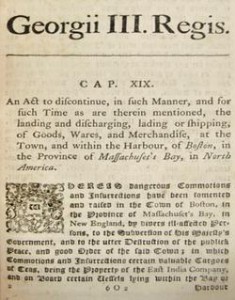
The written document of the Intolerable Acts
Source: https://rootsoftherevolution7-1.wikispaces.com/Intolerable+Acts
In 1774 parliament was told about the Boston tea party. Parliament wanted the Americans to pay for what they did but of course they didn’t. Parliament passed a series of acts that were meant to punish Boston and the state of Massachusetts, to assert British authority known as the intolerable acts. The acts were the Boston Port Act, Massachusetts Government Act, Quartering Act, Administration of Justice Act and the Quebec Act. Colonist felt their rights were violated by these acts because they were far too extreme harsh and unfair.
First Continental Congress:
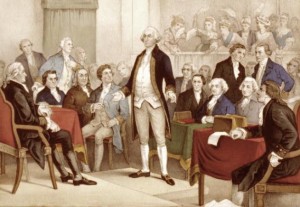
Delegations of the colonies assembled at the First Continetal Congress
Source: http://otecorporation.com/portfolio/first-continental-congress/
In 1774 all 13 colonies sent delegates to the first continental congress. The First Continental Congress began defying the British government. Colonist leaders started demanding that no one buy goods from England, and began cutting economic ties to England. They also demanded the intolerable acts to be repealed but King George rejected the colonist petition. British soldiers were removed from the colonies and the rebellion started so people began storing weapons and ammunition.
Components
Battle of Lexington and Concord:

American Militia firing at the Minutemen retreating
Source: http://www.kidport.com/reflib/usahistory/americanrevolution/lexingtonbattle.htm
In 1775 General Thomas Gage was sent to Boston to disarm the colonists and arrest the leaders of the rebellion, namely John Hancock and Samuel Adams with 700 men. The leaders of the rebellion were forewarned so they moved their weapons before the British soldiers arrived and created a militia called the minutemen to fight the British. When the British arrived at Lexington someone fired and the war began but, the 70 militiamen were pushed back by the Red Coats to a bridge past concord where the Red Coats destroyed colonist cannons. A battle quickly then erupted at the bridge and in a sudden turn of events the Red Coats retreated. This Battle gave the colonist hope and marked the official beginning of the war. Also as the British retreated many colonist sniped at the army.
Bunker Hill:

Source: http://www.ducksters.com/history/battle_of_bunker_hill.php

British soldiers rushing over the Hill
Source: http://www.ducksters.com/history/battle_of_bunker_hill.php
On 1775 Artemas Ward ordered American soldiers to Charleston peninsula overlooking Boston their destination was Bunker Hill, but by mistake the American soldiers went Breed Hill closer to the British position. Major General William Howe told British soldiers to rush the Americans over the hill even though he could have easily surrounded the Americans with his ships. This was a major mistake that killed thousands of British soldiers because it took three waves of men to take over the hill. On the third wave the Americans ran out of ammunition and had to fight with their hands. After this battle the American leader George Washington crafted a plan to take command of the new American Army and form a chain of command. Of course the British Army was known doing this too.
Thomas Paine’s Common Sense:
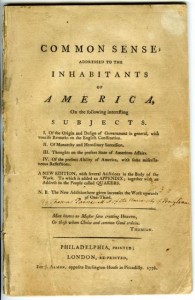
Front page of Thomas Paine’s Common Sense book
Source: https://lib.stanford.edu/american-enlightenment/royal-republican
On 1776 Thomas Paine published a book about independence because arguments were growing. This book was called Common Sense and it would provide that extra push to Americans believing in independence. The book immediately became a bestseller and his two main points were arguing independence from England and the creation of a democratic republic. He wrote in the language of the people, often quoting the Bible in his arguments. He also had many attacks on King George III. This book influenced the patriot cause even though Thomas was new to the 13 Colonies but, Thomas was unlinked and not Recognized for his work at the time.
Declaration of Independence:
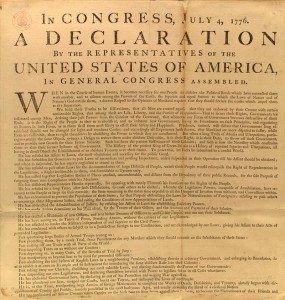
George Washington’s copy of the Declaration of Independence
Source: https://www.loc.gov/exhibits/treasures/trt024.html
The moment had finally come. Far too much bad blood existed between the colonial leaders and the crown to consider a return to the past so the colonial leaders decided that Thomas Jefferson was the man to write a Declaration of Independence. The Declaration was a formal legal document that announced to the world the reasons that led the thirteen colonies to separate from the British Empire. This document had phrases like “ALL MEN ARE CREATED EQUAL,” and “unalienable rights,” but it was mostly a set of abuses that were blamed on King George III. Even though the declaration stated all men were created equal people still had slaves. All they needed was the colonial leaders to vote in favour of this document and on July 4, 1776 it was approved by a twelve to zero vote.
Battle of Trenton:
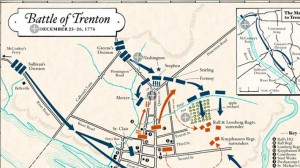
Source: http://www.pbslearningmedia.org/resource/mv15-soc-ush-wintermap/winter-campaign-map/

General George Washington’s army crossing the icy Delaware
Source: http://www.history.com/topics/american-revolution/battles-of-trenton-and-princeton
For the most part the morale of patriots was low at this point because of their ragtag Continental army but they still had some hope. General Washington planned an attack on the Hessians from three directions to be executed on December 26, 1776, the day after Christmas. When they executed this plan the Continental army crossed the Delaware river during brutal weather conditions and they had to walk nine miles to Trenton. Then Washington’s army was joined by armies under the command of Generals Nathaniel, Greene and John Sullivan. When the battle began hessian forces were overrun and they surrendered in the city, almost no one escaped because the Americans sealed off all escape routes. Although the battle was not important tactically, it inspired the American war effort and raised the morale of the army.
Battle of Saratoga:

Patriots defeating the British Army in the Battle of Saratoga
Source: http://ashleighgrace.com/article/the-notorious-benedict-arnold/
The British wanted to end the war quickly by planning to cut off New England from the rest of the colonies by taking New York, Albany and the Hudson River. British Generals Burgoyne, St. Leger and Howe would meet at Albany to defeat the rebel armies. However the stubborn General Howe had different plans, to attack the patriots in philadelphia but he got trapped by the bad weather conditions and St. Ledger army was cut of by Benedict Arnold’s army. Also Burgoyne’s army became trapped in Saratoga blocked by General Gates and his army. On October 7, 1777 Burgoyne attempted to attack the larger Patriot force, but Burgoyne’s army was defeated by Arnold’s army at Bemis Heights. Due to a lack of supplies and high casualties Burgoyne surrendered. The Patriot victory at Saratoga was a turning point in the war that renewed the morale of the Americans. It convinced France the Americans could win the war and France decided to support the Americans. France sent generals, troops, ships, supplies and money to help Americans win the war.
Battle of Camden:
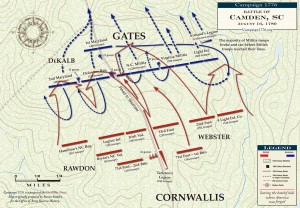
Source: http://www.campaign1776.org/battlefields/camden/maps/camden.html
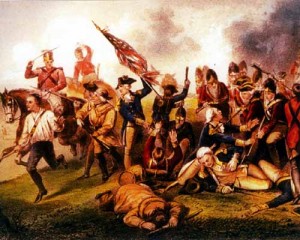
The British Army overtaking the Americans at the Battle of Camden
Source: http://www.britishbattles.com/battle-camden.htm
In 1780, the British had shifted their military strategies to focus on the southern colonies where they would face a new American army. This second southern army was commanded by Horatio gates who was voted in by the continental Congress because he was the hero of the Battle of Saratoga. Horatio Gates buoyed with confidence marched his ragtag army to southern Carolina at British lines, but by the time they got there almost half of the army had disease. When British General Cornwallis heard about the American movement he brought his army to meet the Americans. After the armies did meet the Americans were overrun because their lack of military experience. Then Americans fled because of a hard right flank from the British. The battle resulted in total devastation for the Patriot southern army as over a thousand were captured and 900 were killed or wounded. The army’s artillery and baggage train were also capture.
Battle of Cowpens:
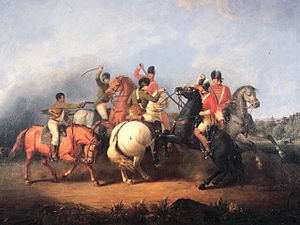
American Militia defeating the British in the Battle of Cowpens
Source: https://en.m.wikipedia.org/wiki/Battle_of_Cowpens
On October 14, 1780, General Morgan’s army which was a detachment from Nathaniel Greene’s army was assigned to protect the locals living in between the Broad and Pacolet Rivers but, Morgan was being followed. He was being followed by Tarleton’s army who thought Morgan was going to attack. When the armies finally engaged they were positioned between two rivers so that no one could escape and Tarleton’s army was exhausted from following Morgan’s army. After initial British charge the first two lines of Patriot fighters withdrew and Tarleton believed the Patriots were in full retreat and ordered soldiers to charge. Tarleton was not aware of a third line of Patriot fighters waiting for the British charge. British forces charged directly into the third line of Patriots who halted British advance with a bayonet charge. British soldiers surrendered and others turn and ran. The British army was outflanked and Patriot forces began attacking the British from behind. British forces began to retreat despite Tarleton urging them to continue fighting. Morgan captured 712 British soldiers and 110 British soldiers were killed. The battle was a major turning point Southern campaign and Cowpens ultimately was the first step in the eventual end of the war as it caused Cornwallis to abandon South Carolina, engage Greene at Guilford’s Courthouse and eventually withdraw his army to Yorktown where his army would eventually come under siege and surrender.
Battle of Guildford Courthouse:
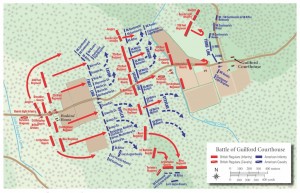
Source: http://www.armchairgeneral.com/the-battle-of-guilford-courthouse.htm
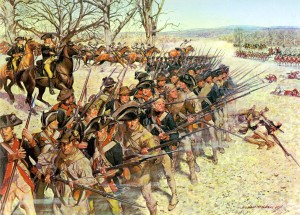
American Soliders Preparing for the Battle of Guildford Courthouse
Source: https://en.m.wikipedia.org/wiki/Battle_of_Guilford_Court_House
After the embarrassing British defeat by the Patriots at the Battle of Cowpens, British General Charles Cornwallis wanted to Attack Nathaniel Greene’s army in North Carolina despite having half of the troops. Much like the Battle of Cowpens, General Greene had prepared in advance for an attack so he positioned his army in three lines, but they were too far away to support each other. When the armies meet the British immediately advanced on the first two lines despite the fire power from American cannons. British then reached the third line and hand to hand combat engaged. Then the desperate Cornwallis decided to fire heavy guns and cannons over his own soldiers and into the Patriot third line on the hill. This killed many British soldiers but was proved effective because it made all of Greene’s army retreat. Cornwallis army suffered many casualties from this battle even though they won but soon Cornwallis would led his battered army to Yorktown.
Battle of Yorktown:

American troops storming the redoubt
Source: http://www.britishbattles.com/battle-yorktown.htm
By 1780, the Revolutionary War was raging in both the North and the South, and French forces had fully committed in the American effort to defeat the British. The French and American forces created a plan to end the war quickly by combining armies and marching to Yorktown to trap Cornwallis in Virginia. This meeting confused the British because the American/French leaders meet just outside of New York and the British thought that they were going to attack there, preventing British from sending troops to help in Yorktown. Soldiers had to March 200 miles in two weeks, the plan worked perfectly and American forces started building trenches close to British bases so that they could store heavy artillery in them. The Americans closed in on the British with their firepower by moving Heavy artillery closer and closer after destroying their bases. Eventually with Alexander Hamilton leading the way the Americans defeated the British. Then Cornwallis tried desperately to escape with his army on the river but the bad weather held them back and forced Cornwallis to surrender. 2 days later the British officially surrendered and the Americans took more than 7,000 British troops to prison and the entire Revolutionary War had nearly come to an end. Yorktown would be the last major battle of the war.
Consequences
Treaty of Paris:

Benjamin West’s painting of the delegations at the Treaty of Paris
Source: https://en.m.wikipedia.org/wiki/Treaty_of_Paris_(1783)
Britain agreed to recognize American independence. They gave Americans fishing rights to the Grand Banks off the coast of Newfoundland. Also Britain granted U.S. all territory between Allegheny Mountains on the east and Mississippi River on the west.
Loyalist:

Thomas Hutchinson was hung in effigy many times for being a American loyalist
Source: http://www.ushistory.org/us/13c.asp
Approximately 20% of American colonists supported British rule and remained loyal. They were persecuted by the Patriots during the war. Also patriots abused them and burned their homes and farms after the revolution. The Treaty of Paris was signed, between 80,000-100,000 Loyalists had to leave U.S. Many settled in other British colonies in North America Quebec, Nova Scotia and Island of St. John (PEI).
Constitution:

Page one of the original copy of the Constitution
Source: https://en.m.wikipedia.org/wiki/United_States_Constitution
The constitution outlines the structure and powers of Government. Three branches of government were formed and are separate, balanced off by the power of the other two. U S states that the constitution is supreme and all persons are equal before the law. Also people can change the constitution.
Bill of rights:

The signing of the Bill of rights
Source: http://www.crf-usa.org/b-o-r-day/bill-of-rights-day.html
The first 10 amendments (additions) checked of the constitution. They represent ideals regarding individual liberty, limited government, and the rule of law.
Worldwide influence:

Ordinary Americans cheering because of their independence
Source: https://libcom.org/history/peoples-history-american-revolution
American Revolution spread ideas of liberty, individual rights and equaldity to other parts of the world. It influenced and inspired other revolutions around the world such as France in 1789. American Declaration of Independence had some impact on the French Declaration of the Rights of Man and the Citizen of 1789.